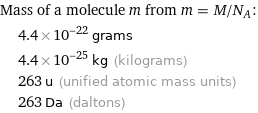Input interpretation

5-chloro-2-thienylzinc bromide | molar mass
Result

Find the molar mass, M, for 5-chloro-2-thienylzinc bromide: M = sum _iN_im_i Plan: • Write the chemical formula and gather atomic masses from the periodic table. • Determine values for N_i and m_i using these items. • Finally, compute the mass. Write the chemical formula: C_4H_2BrClSZn Use the chemical formula, C_4H_2BrClSZn, to count the number of atoms, N_i, for each element: | N_i Br (bromine) | 1 C (carbon) | 4 Cl (chlorine) | 1 H (hydrogen) | 2 S (sulfur) | 1 Zn (zinc) | 1 Look up the atomic mass, m_i, in g·mol^(-1) for each element in the periodic table: | N_i | m_i/g·mol^(-1) Br (bromine) | 1 | 79.904 C (carbon) | 4 | 12.011 Cl (chlorine) | 1 | 35.45 H (hydrogen) | 2 | 1.008 S (sulfur) | 1 | 32.06 Zn (zinc) | 1 | 65.38 Multiply N_i by m_i to compute the mass for each element. Then sum those values to compute the molar mass, M: Answer: | | | N_i | m_i/g·mol^(-1) | mass/g·mol^(-1) Br (bromine) | 1 | 79.904 | 1 × 79.904 = 79.904 C (carbon) | 4 | 12.011 | 4 × 12.011 = 48.044 Cl (chlorine) | 1 | 35.45 | 1 × 35.45 = 35.45 H (hydrogen) | 2 | 1.008 | 2 × 1.008 = 2.016 S (sulfur) | 1 | 32.06 | 1 × 32.06 = 32.06 Zn (zinc) | 1 | 65.38 | 1 × 65.38 = 65.38 M = 79.904 g/mol + 48.044 g/mol + 35.45 g/mol + 2.016 g/mol + 32.06 g/mol + 65.38 g/mol = 262.85 g/mol
Unit conversion

0.2629 kg/mol (kilograms per mole)
Comparisons

≈ 0.36 × molar mass of fullerene ( ≈ 721 g/mol )

≈ 1.4 × molar mass of caffeine ( ≈ 194 g/mol )

≈ 4.5 × molar mass of sodium chloride ( ≈ 58 g/mol )
Corresponding quantities

Mass of a molecule m from m = M/N_A: | 4.4×10^-22 grams | 4.4×10^-25 kg (kilograms) | 263 u (unified atomic mass units) | 263 Da (daltons)

Relative molecular mass M_r from M_r = M_u/M: | 263